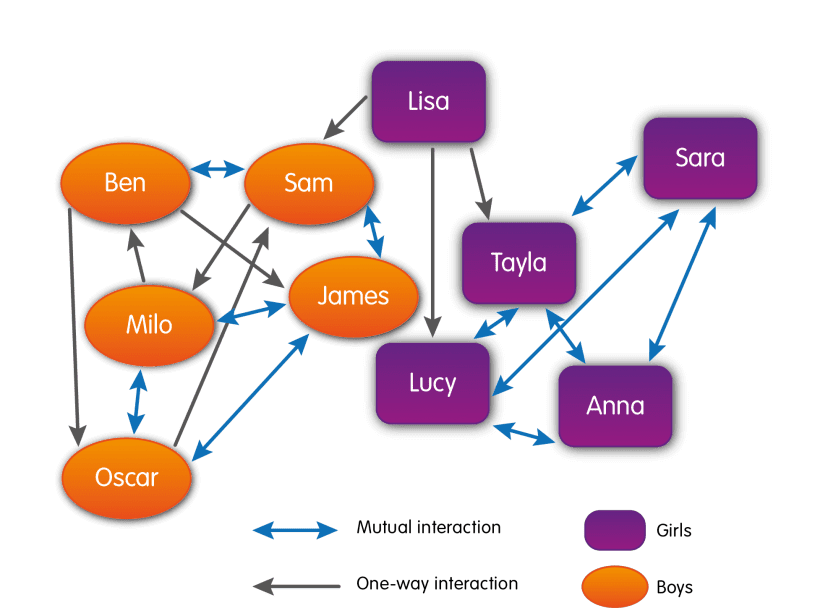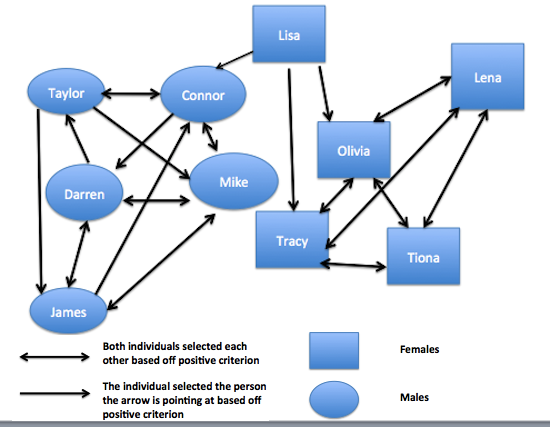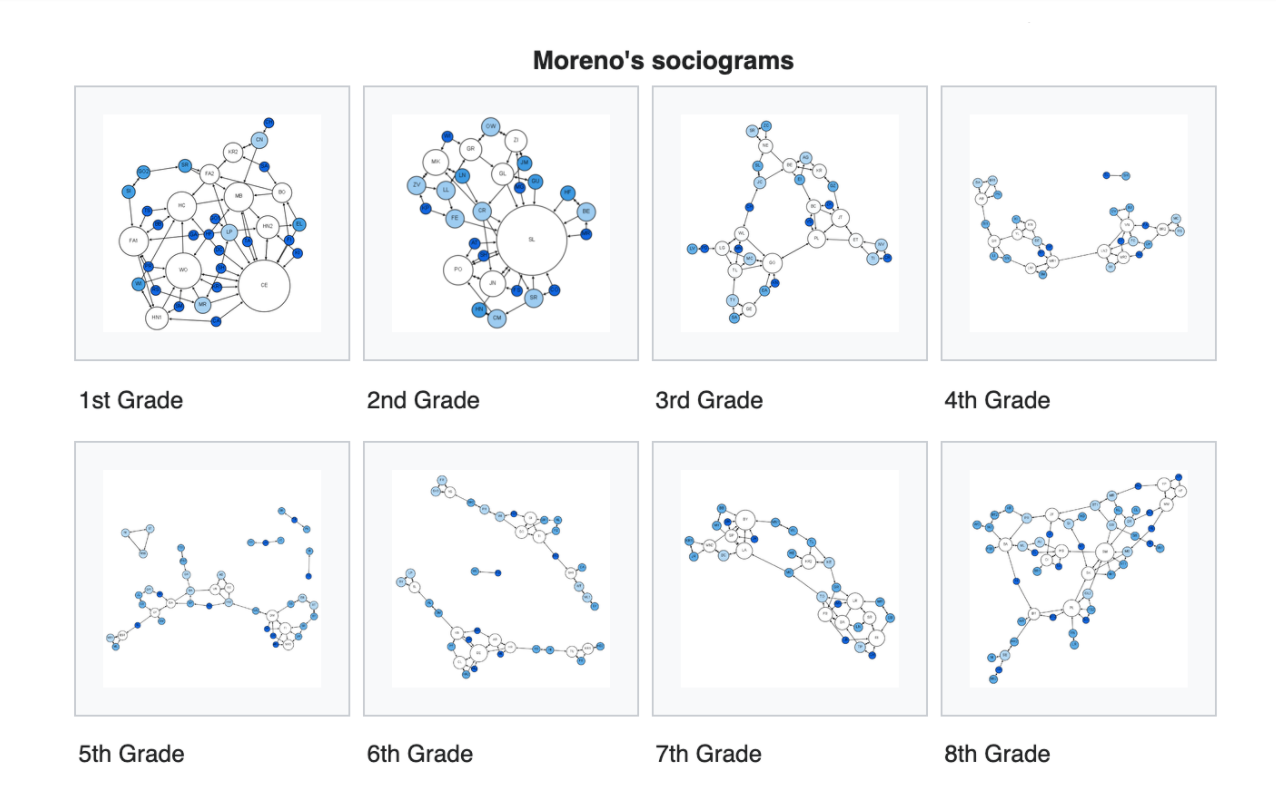“No man or woman is an island.” But if they feel like they are on an island, you, as a leader, need to know. The sociogram is a leadership tool that provides valuable, objective data on relationships and social dynamics.
by Michael Miller
What Is a Sociogram? Definition of a Sociogram
A sociogram is a tool for charting the relationships within a group. It’s a visual representation of the social links and preferences that each person has – valuable data for leaders.
Sociogram Examples
To construct a sociogram, ask each person to confidentially list two other people to work with on an activity. The topic does not matter. In most cases, the social relationships will be relatively constant regardless of the activity. (I have heard counter arguments that the topic does matter, and that would make sense depending on the context. if the social relationships change based on the activity, that is also valuable data.)
Make sure they put their own name on the top of the paper. Then you write up this data as a chart. Arrows indicate who is choosing whom. The green arrows indicate that those people chose each other:


How to Interpret a Sociogram
Here are three patterns to look for when breaking down a sociogram:
Isolates – One of the alerts a leader gets from this is that there are some people – the isolates – who no one has chosen or who have only been chosen by another isolate. In the sociogram above, Sam is an isolate and so is Jill, having only been chosen by Sam. While it is wise to have a certain degree of philosophical skepticism in making initial assumptions about isolates, they are a cause for concern. You want to make sure they feel connected and supported in the larger group.
Cliques – There are several quite tight groups which may merit some degree of skepticism. Are these groups “cliques” that exclude others? Cliques are defined as groups of three or more people within a larger group who all choose each other. In the above example, Ann, Fleur and Meg have all chosen each other, and are clearly a tight group. You may want to observe to make sure they aren’t excluding other people.
Stars – Stars are people who have been chosen many times on the sociogram. These people are generally popular and well-liked, hence being chosen by many of their peers. In the example given above, can you find one of the Stars?
Remember, this is simply a guide. If nothing else, the sociogram can be used as a guide for further, more focused, observation.
History of the Sociogram
The sociogram is a tool within the social science discipline of sociometry, a quantitative method for measuring social relationships developed by psychotherapist Jacob L. Moreno and Helen Hall Jennings. The sociogram was invented by Moreno.
Here are his original drawings:

More Tools for Gathering Social and Emotional Data
If you want other tools for gathering valuable social and emotional data, check out Six Seconds’ Brain Profiles and the SEI, the world’s leading emotional intelligence assessment:
- Pursue Noble Goals in the Six Seconds Model of EQ - July 29, 2023
- Increase Empathy in the Six Seconds Model of EQ - July 26, 2023
- Exercise Optimism - July 24, 2023


Very useful article, but as one of the above commentators mentions, the names in the article do not correlate to the diagrams provided (the text also refers to a Ann, Fleur and Meg who do not even appear in the sociograms provided above the article)
“You need to be able to deal with the reactions of participants when they are over or under chosen and work with the group to appreciate the data that is being revealed”.
Please give me practical ideas on how one deals with negative participant reactions so that all participants embrace and appreciate the data revealed by the sociogram.
I’m confused.
Sam is not an isolate; he’s a star, along with Lucy.
Lisa is an isolate.
And there is no Jill.
I thought the same thing?
I also submitted this comment on the classroom section of six seconds, and think it worth posting here.
Sociograms are powerful tools for working with groups. They were first developed by Jacob Moreno back in the 1920s and 30s. (Moreno also developed psychodrama, sociodrama and a number of other methods of working.) He used sociometry, the original theory from which sociograms come, to reduce absconding from a girls borstal by identifying and strengthening meaningful connections.
One way to focus the work of the sociogram is with adequate warm up. Some teachers or managers just ask participants who their two best friends are, which would be minimal warm up. Or you could introduce the idea that some people in the group would be better than others to help you with a specific task, say doing a math problem. This exercise is not a popularity pole but an opportunity for you to think about who would best help you to do this this math assignment.
You could repeat the exercise using different criteria. Someone who is an isolate on one criteria may be a star in another criteria.
The sociogram can also be done in action. You make your choice by placing your hand on the shoulder of the person you choose to help you with a math assignment. Then everyone gets to see and you allow time for each person to share with the person they have chosen something of their reason for the choice. Then you invite group members to make their second choice.
Conducting action sociograms is best done when you have had some training in the method, which is part of the psychodrama training curriculum in most countries. You need to be able to deal with the reactions of participants when they are over or under chosen and work with the group to appreciate the data that is being revealed.
Is it possible to draw sociogram through qualitative data? I am planning to use sociogram for social network analysis among migrant population. can you help me with this? i am in need of personal assistence in doing sociogram
what are the instructional implications of and isolate and star individuals